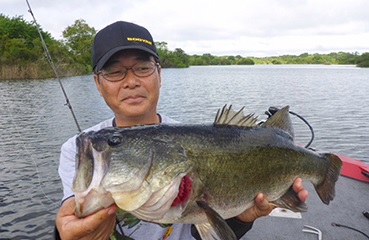 When a bass blows up on topwater lure you need to wait a moment to make sure the fish got the lure and to prevent jerking the lure away. Right?
When a bass blows up on topwater lure you need to wait a moment to make sure the fish got the lure and to prevent jerking the lure away. Right?
That’s certainly the most common school of thought, but it is the wrong response in the mind of topwater expert Hiro Naito – at least for the larger bass that Naito always targets. Naito sets the hook hard as soon as a surface strike occurs, and he’s confident that he lands quite a few big bass he would have lost in battle had he hesitated.
Does Naito occasionally snatch a lure away from a fish? Sure. He doesn’t think those are usually the ones he wants, though. And for those bass that do fully take the lure, the human reaction time isn’t fast enough to pull away the lure before the bass clamps down.
Naito’s first concern is getting a strong hookset with good penetration and then turning a large fish’s head in his direction before it has the chance to turn and dig into vegetation, under limbs or around other cover. With a really large bass, that moment gained by not waiting makes all the difference for gaining momentum and getting the bass moving in the proper direction.
“I go after big bass, so I want control of as many things as possible,” Naito said, “and once a fish is hooked the first thing I want to control is the direction of that fish’s head.”
Even with those fish that blow up near a lure but fail to get it, Naito isn’t convinced that he loses anything by setting the hook and yanking the lure away. The bait sails away clean, and he can then make a follow-up cast either to the exact spot or just past the spot, to repeat the presentation, as opposed to drawing the fish away from its ambush point to a place where it might be less inclined to ever strike.
Whether or not he get a follow-up strike on a miss, Naito will always set the hook first and ask questions later. “If I were to wait, by the time I knew whether a bass got my lure, it might be too late.”

